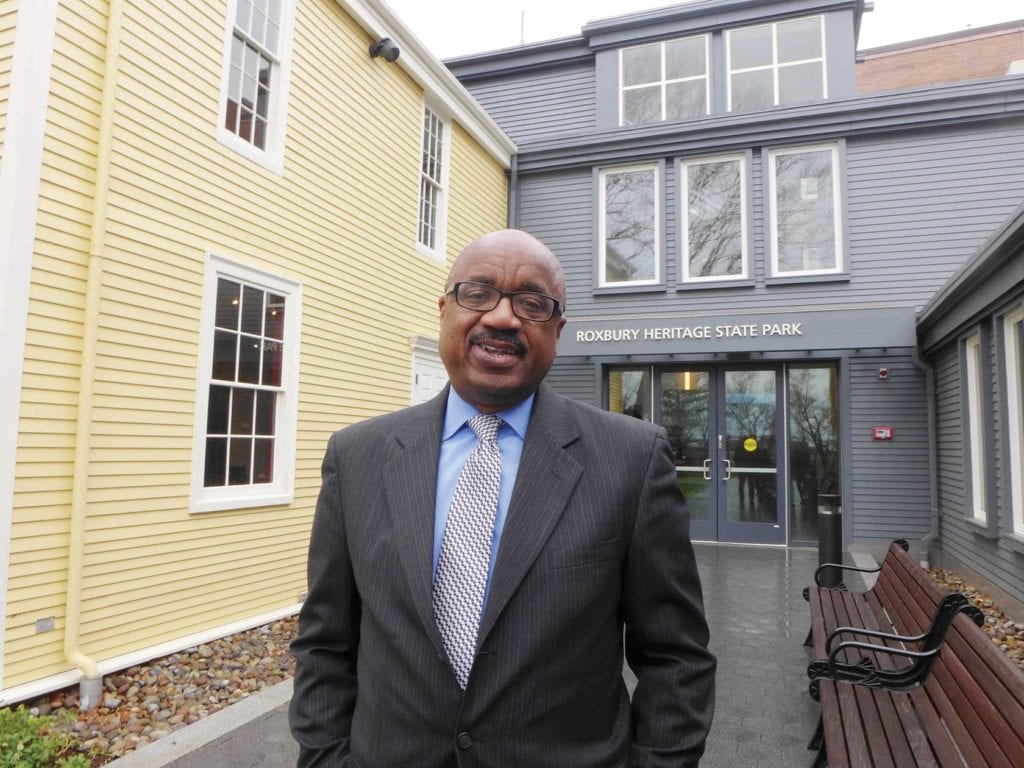Roxbury Heritage State Park reopens with renovated Dillaway-Thomas House

Growing up in the Fort Hill section of Roxbury, Leonard Lee knew he lived in the shadow of history. Right in John Eliot Square, the 1803 First Church, the 1752 Dillaway-Thomas House and the 1853 Norfolk House have stood unaltered in the face of the sweeping changes that Roxbury has seen in recent decades.
Now as manager of Roxbury Heritage State Park, Lee, too, is stationed in John Eliot Square, safeguarding the historical treasures of the colonial-era Dillaway-Thomas House.

State Rep. Chynah Tyler, former Rep. Byron Rushing and Rodnell Collins with a painting of Malcolm X, who spent part of his childhood in Roxbury. BANNER PHOTO
“It’s really like coming home,” he told an audience at the First Church parish hall Monday during the annual Roxbury Patriots Day observance.
The state’s Department of Conservation and Recreation recently completed $3.6 million in renovations at the two-story Dillaway-Thomas House. Monday, Lee led a crowd through the rooms of the museum, which served as the headquarters of Revolutionary War General John Thomas during the 1775 Siege of Boston.
The rooms feature displays of historical artifacts and interactive maps that reflect the history of the Roxbury era from its pre-colonial Native American settlements through its evolution into a predominantly black community in the mid-20th century.
One display on a large LCD screen shows 15th century Native American sites including a fish weir, a seasonal camp and a lithic workshop where stone tools were manufactured. Another shows Roxbury in the 1650s, with sites including the first Meeting House, the home of Puritan Pastor John Eliot, the Roxbury Latin School and the Roxbury Burial Ground outside present-day Dudley Square.
In the 1775 map, the colonists’ powder house and British army lines of fortification along the Roxbury Neck are shown. Subsequent maps document Roxbury’s evolution from village, to town, to city, to neighborhood of Boston.
Among the 20th century items are a portrait of Malcolm X, who spent part of his childhood in the neighborhood, a reproduction of a Roxbury street scene by painter Alan Rohan Crite and photographs of recent Roxbury luminaries including Nation of Islam Minister Louis Farrakhan, retired television reporter Sarah Ann-Shaw and arts patron Elma Lewis.
“The displays give an idea of how Roxbury has evolved,” Lee says to a group touring the building. “We talk about past, present and future as we go through the museum.”
The wide plank flooring, wainscoting and mantles for the home’s many fireplaces are all wearing fresh paint. New wallpaper in historical patterns adorn each room. A large, colonial-era hearth greets visitors as they enter through the former kitchen of the home, which was built as a parsonage for Rev. Oliver Peabody, who died in 1752 before the home was completed.
In the cupboards are replicas of foods that would typically occupy a colonial-era larder, including Roxbury Russet apples.
“The Roxbury Russet was well-known because it kept very well,” chimes in Roxbury resident Jon Ellertson. “If you stored it properly, it would keep till the following spring.”
On the second floor, a long gallery room will be available for community meetings and art exhibitions, Lee noted.
Also on the second floor are more historical rooms and a reference library, which has not yet opened. South-facing windows look out on Eliot Square while the north-facing windows look toward downtown.
“This is the window where General Thomas watched Charlestown burn,” Lee said, referring to the 1775 battle where British troops torched the settlement to prevent snipers from attacking their troops.
The Dillaway-Thomas House is the oldest-surviving building in Roxbury. It was first restored in 1930. In the 1980s, former state Rep. Byron Rushing secured funding to restore the house and introduced legislation that secured state park designation for the one-acre parcel on which the building sits. Local artist Napoleon Jones Henderson recalls that in the 1980s, Roxbury community members hosted jazz concerts at the building.
The recently-completed $3.6 million, five-year renovation has restored the house to a much higher standard, Jones Henderson notes.
“They’ve made it look more like a house someone actually lived in,” he said.
The Dillaway-Thomas House will be open Wednesdays, Thursdays and Saturdays from noon to 5 p.m. On Sundays, it will be open from 10 a.m. to 4 p.m. The grounds will be open every day from 9 a.m. to 8 p.m.
Lee stressed to visitors that he is open to community input on programming and even on modifications to the historical displays.
“For me, this is about relationships,” he told the tour participants. “What can we do differently? What do we want this building to show? If you hear anything from the tour today, it’s that this building is your building.”







